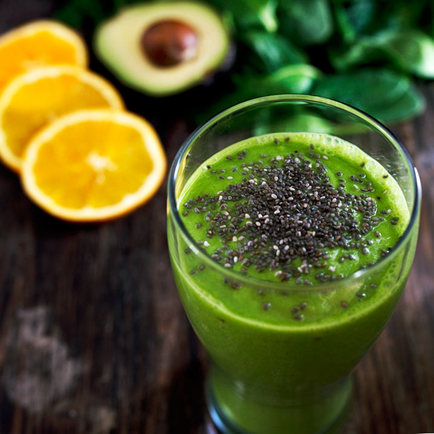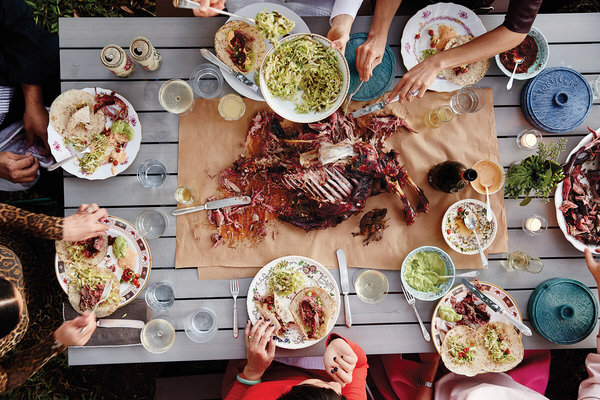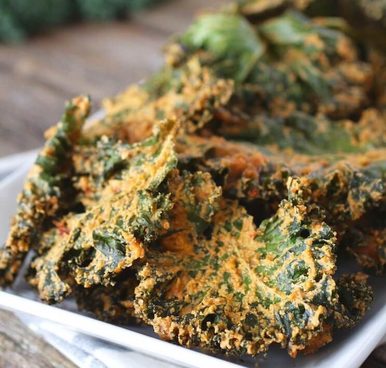|
Sometimes those holiday feasts are just amazing. And it's not just the abundance of delicious food but also the people, the decorations, and the ambiance. It is way too easy (and common) to indulge on those days. But it doesn't always stop there. Sometimes we overeat on regular days. Or at regular meals. Or All. The. Time. Here are three tips to avoid overeating at meals. (Psst, turn these into habits and ditch the willpower!) Tip #1: Start with some water When your stomach is growling and you smell amazingly delicious food it's too easy to fill a plate (or grab some samples with your bare hands) and dive into the food. But did you know that it's possible to sometimes confuse the feeling of thirst with that of hunger? Your stomach may actually be craving a big glass of water rather than a feast. Some studies have shown that drinking a glass or two of water before a meal can help reduce the amount of food eaten. And this super-simple tip may even help with weight loss (...just sayin'). Not only will the water start to fill up your stomach before you get to the buffet, leaving less room for the feast but drinking enough water has been shown to slightly increase your metabolism. Win-win! Tip #2: Try eating “mindfully” You've heard of mindfulness but have you applied that to your eating habits? This can totally help you avoid overeating as well as having the added bonus of helping your digestion. Just as being mindful when you meditate helps to focus your attention on your breathing and the present moment being mindful when you eat helps to focus your attention on your meal. Do this by taking smaller bites, eating more slowly, chewing more thoroughly, and savouring every mouthful. Notice and appreciate the smell, taste and texture. Breathe. This can help prevent overeating because eating slower often means eating less. When you eat quickly you can easily overeat because it takes about 20 minutes for your brain to know that your stomach is full. So take your time, pay attention to your food and enjoy every bite. Bonus points: Eat at a table (not in front of the screen), off of a small plate, and put your fork down between bites. Tip #3: Start with the salad You may be yearning for that rich, creamy main dish. But don't start there. (Don't worry, you can have some...just after you've eaten your salad). Veggies are a great way to start any meal because they're full of not only vitamins, minerals, antioxidants, and health-promoting phytochemicals but they also have some secret satiety weapons: fiber and water. Fiber and water are known to help fill you up and make you feel fuller. They're “satiating”. And these secret weapons are great to have on your side when you're about to indulge in a large meal. Summary: Have your glass of water, eat mindfully, and start with your salad to help avoid overeating at meals. Recipe (Water): Tasty (and beautiful) Pre-Meal Water Ideas If you're not much of a plain water drinker or need your water to be more appealing to your senses here are five delicious (and beautiful looking) fruit combos to add to your large glass of water: ● Slices of lemon & ginger ● Slices of strawberries & orange ● Slices of apple & a cinnamon stick ● Chopped pineapple & mango ● Blueberries & raspberries Tip: You can buy a bag (or several bags) of frozen chopped fruit and throw those into your cup, thermos, or uber-cool mason jar in the morning. They're already washed and cut and will help keep your water colder longer.
1 Comment
Everything You Think You Know About Healthy Eating is Wrong and it's Making You Fat and Tired4/18/2017  Oh my gosh – nutrition and diet info is everywhere! And each expert and association tries to lead you in their direction because they know best and their advice is going to help you. Right? Well, maybe… Everyone has heard (and maybe lived through) the intense focus on how much you eat. This has gotten way too much attention because while this does affect your weight and energy level, it's certainly not the “holy grail” of health. Let's focus a bit more on the often overlooked (and proven) benefits of what you eat and drink and how you eat and drink it. What you eat and drink The “calories in, calories out” philosophy (i.e. how much you eat) is being drowned out with research on other factors that may be just as important. Don't get me wrong limiting calories, carbs or fat can certainly help you lose weight but that's simply not the only factor for long-term weight loss and maximum energy for everyone. When the intense focus on how much we ate didn't work in the long-run it wasn’t really a surprise. We kinda knew that already, didn't we? You can certainly still continue to count your calories, carbs, and fat but don't forget to also pay attention to what you eat. Ideally, you need a varied diet full of minimally-processed foods (i.e. fewer “packaged” “ready-to-eat” foods). This simple concept is paramount for weight loss, energy, and overall health and wellness. Every day this is what you should aim for:
How you eat and drink Also pay attention to how you eat and drink. Studies are definitely showing that this has more of an impact than we previously thought. Are you rushed, not properly chewing your food, and possibly suffering from gastrointestinal issues? Do you drink your food? When it comes to how you eat let's first look at “mindful eating”. Mindful eating means to take smaller bites, eat slowly, chew thoroughly, and savour every bite. Notice and appreciate the smell, taste and texture. Breathe. This gives your digestive system the hint to prepare for digestion and to secrete necessary enzymes. This can also help with weight loss because eating slower often means eating less. Did you know that it takes about 20 minutes for your brain to know that your stomach is full? Thought so! We also know that more thoroughly chewed food is easier to digest and it makes it easier to absorb all of those essential nutrients. And don't forget about drinking your food. Yes, smoothies can be healthy and a fabulously easy and tasty way to get in some fruits and veggies (hello leafy greens!) but drinking too much food can contribute to a weight problem and feelings of sluggishness. Don't get me wrong a green smoothie can make an amazingly nutrient-dense meal and is way better than stopping for convenient junk food – just consider a large smoothie to be a full meal not a snack. And don't gulp it down too fast. If your smoothies don't fill you up like a full meal does try adding in a spoon of fiber like ground flax or chia seeds. Summary: Consider not only how much you eat but also what and how you eat it. Recipe (Smoothie meal): Chia Peach Green Smoothie Serves 1 handful spinach 1 tablespoon chia seeds 1 banana 1 chopped peach 1 cup unsweetened almond milk or water Add ingredients to blender in order listed (you want your greens on the bottom by the blade so they blend better and have the chia on the bottom to absorb some liquid before you blend). Wait a couple of minutes for the chia seeds to start soaking up the almond milk. Tip: Use water instead of milk when your smoothie is to be a snack instead of a meal. Blend, Serve and Enjoy! Tip: Smoothies are the ultimate recipe for substitutions. Try swapping different greens, fruit or seeds to match your preference. Bonus: Chia seeds not only have fiber and essential omega-3 fatty acids but they contain all of the essential amino acids from protein. One of the biggest concerns that you may have about maintaining a low-carb lifestyle is staying full. Without a large quantity of carbohydrates to fill your meals, you may wonder if you will feel hungry. Try these tips to avoid that low-carb hunger: 1. Ground almond flour. Instead of using regular flour, switch to ground almond flour for your meals.
2. Cauliflower. Did you know that you can use cauliflower as a substitute for mashed potatoes?
3. Spiralized vegetables. A spiralizer is a simple kitchen tool that you can use to make vegetables into tiny strips that resemble noodles. If you don’t have a spiralizer then you can use vegetable peeler to make larger noodle strips.
4. Lettuce wraps. One of the easiest low-carb hacks is to make wraps or tortillas with lettuce instead of flour items.
5. Vegetable chips. Regular potato chips won’t work on a low-carb diet, but vegetable chips you make yourself at home are fine.
6. Use citrus flavor. Lemons and limes make great low-carb substitutes for traditional salad dressings and sauces that may have too many calories. A squeeze of lemon or lime can add instant flavor to a salad, soup, casserole, or other dish.
7. Be creative. The key to staying satisfied on a low-carb diet is to think of creative ways to use the healthy ingredients in your kitchen. A simple tomato and lettuce can turn into a fun meal with the right low-carb sauce.
A low-carb diet doesn’t have to be boring or unsatisfying. Use these tips every day to feel full and happy while eating low-carb. For a delicious kale chips recipe, click here to download ---->>> KALE CHIPS
|
Archives
November 2022
Categories
All
|


 RSS Feed
RSS Feed